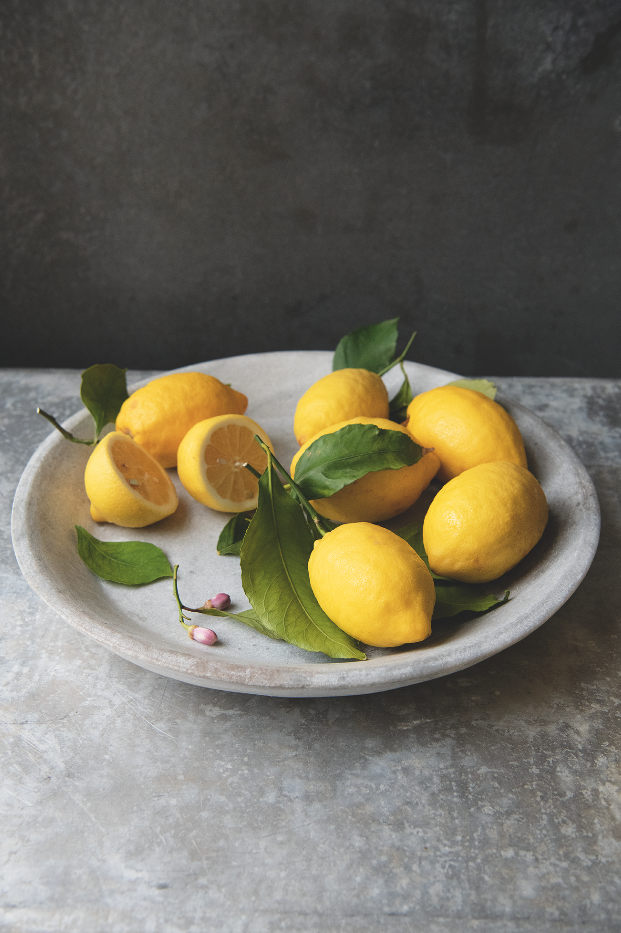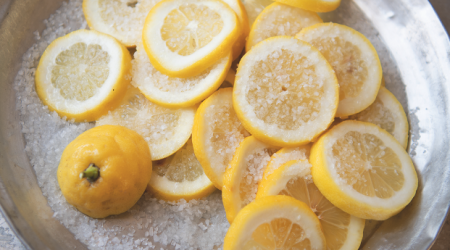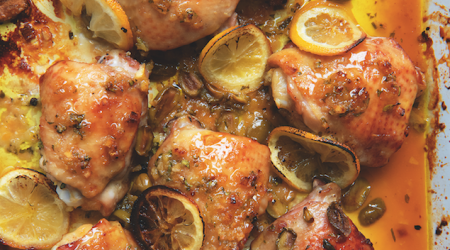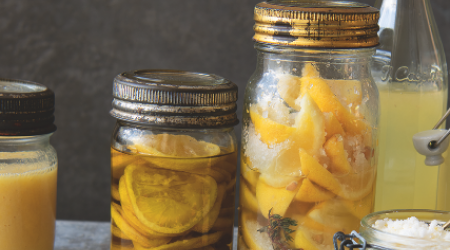Lemons
Sprinkle a little sunshine into your dishes this month. The most cheery of citrus fruits, lemon is an indispensable and everyday ingredient for cooks and bartenders alike. Clarissa Hyman has the juice
Sorrento lemons are the best of the zest: it is impossible to imagine the Amalfi and Sorrento coasts without their fragrant lemon gardens. Gardens, not orchards – steep terraces where the painterly contrast between the blue sea, light yellow fruit, ivory blossom and dark green foliage is dramatic. Sorrento lemons, protected by European recognition, are the connoisseur’s lemon, perfumed, fleshy and brightly acidic with a pedigree that dates back to the 17th century. Demand is so high, prices are often double that of ordinary lemons. At the beginning of the 20th century, these lemons were even quoted on the New York Stock Exchange.
The fruit from Campania is at its best from spring to the end of autumn, but much of the limited harvest goes into the production of limoncello. Lemons, however, are one of the few imported fruits we are fortunate enough to find year-round, as they can be grown in a range roughly 35 degrees north and south of the equator. They prefer the sub-tropics as they can suffer from blight and virus in excessive tropical heat. Nor can they tolerate frost. The most widespread cultivar is Eureka, which originated in Sicily and was introduced to California in 1858, where they still produce more lemons than in the whole of Europe combined.
Luminous and sensual, the vivid colour, sweet curved shape, aromatic peel and sharp, acidic flavour of this prince of citrus fruits evokes images of Silk Roads and Spice Routes, traders and travellers, poets and princes, and romantic tales set amid verdant groves and delicate fountains. Although the Romans were familiar with them as a decorative curiosity from Asia, it was with the Arabic occupation of Spain and Portugal, Al-Andalus, that the lemon and its siblings really arrived in Europe.
The English word ‘lemon’ derives from the Spanish limon, which in turn comes from the Arabic laimun and the Persian limu. The Arab understanding of the needs of irrigation in the semi-arid climate of Southern Spain enabled them to plant exquisite gardens and citrus groves that hinted of an earthly paradise. Their oriental romantic allure captivated Thomas Moore, for one, who was inspired to write, ‘A Persian heaven is easily made; ‘tis but black eyes and lemonade’.
Cultivated Arabs knew how to use the lemon in cooking, and they were soon a familiar sight throughout Europe, although some remained suspicious of fruit they connected with summer heat, dysentery and malaria. They feature especially in Dutch still life-paintings, nearly always with wine nearby. The peel was usually depicted cut in a glistening spiral on gold, silver and pewter plates to show it was both used to flavour spirits and as a sign of affluence.
One of the earliest recipes using lemons, published in the mid-16th century by the Archbishop of Milan’s chef Cristoforo di Messisbugo, was for marinated brill with lemon slices. In France, the chef and writer François Pierre de la Varenne popularised their use when he broke away from the heavy porridge stews of medieval times and devised piquant sauces made of meat juices combined with lemon juice, vinegar or verjuice.
It is now impossible to imagine cooking without a lemon within easy reach to add accent, sharpness, juice and zest to dishes that would otherwise be flat, dull and two-dimensional. The fruit works both as a pleasant souring agent and a flavour enhancer, adding lustre, in particular, to fish, shellfish and poultry. The juice can ‘cook’ white fish in ceviche, and stop the browning from oxidation of cut fruit. The zest gives a bright kick to cakes and sweets – lemon meringue, lemon cake, lemon curd – and pancakes with lemon never lose their attraction. Lemon also brightens savoury stuffings and sauces, pairs naturally with herbs and oils, and has a particular affinity with capers, garlic and herbs. Pickled lemons are a magical addition to North African tagines. And the world would be a much poorer place in hot weather without a glass of lemonade or citron pressé.
According to an old Spanish proverb, the equivalent of an apple a day is the trinity of garlic, onion and lemon: with a good daily dose, they say, you can forget the need for pills and doctors. Indeed, the lemon is rich in vitamin C without which we would fall sick from diseases such as scurvy, the affliction suffered by European sailors who, centuries ago, set out to circumnavigate the globe. Lemons also contain soluble fibre and plant compounds that are said to help in a range of other health benefits, such as managing blood pressure.
In order to transport them, they are picked slightly green: to release as much juice as possible, keep your lemons at room temperature or cover with boiling water and leave to stand for five minutes before squeezing. If cooking with the peel, however, avoid lemons that have been treated with sprays, dyes or wax, or make sure to give them a good scrub before use.
At a pinch, lemons can be kept for a couple of weeks in the fridge, so when the recipe calls for a squeeze of lemon, there’s little excuse to turn to a plastic yellow bottle that contains a pale imitation of the real thing. Lemons might be a small player in the fruit bowl but they are still deserving of a great deal of respect.
As the saying goes, ‘When life gives you lemons, make lemonade, and try to find someone whose life has given them vodka, and have a party’. Squeeze the day!
This artcile was taken from the February 2024 issue of Food and Travel. To subscribe today, click here.

Recipes
Get Premium access to all the latest content online
Subscribe and view full print editions online... Subscribe







